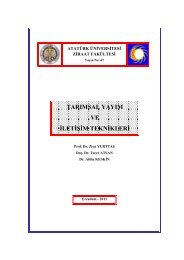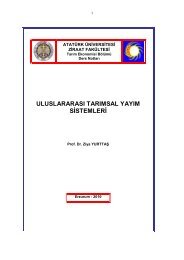INTEGRATED ENGLISH REFERENCE NOTES - Prof. Dr. Ziya Yurttaş
INTEGRATED ENGLISH REFERENCE NOTES - Prof. Dr. Ziya Yurttaş
INTEGRATED ENGLISH REFERENCE NOTES - Prof. Dr. Ziya Yurttaş
Create successful ePaper yourself
Turn your PDF publications into a flip-book with our unique Google optimized e-Paper software.
Erzurum<br />
54<br />
Geography<br />
� Erzurum is located in the north eastern part of Turkey.<br />
� It has always been an important center because of its geographical position and<br />
topographical peculiarities.<br />
� A branch of the ancient Silk Road used to pass through the city.<br />
� It is located on the skirts of majestic Palandöken Mountains, overlooks a large<br />
plain and controls several passes to different directions.<br />
� The population of Erzurum is about 400.000.<br />
� The altitude of the city is about 1.800 meters.<br />
� The city is surrounded by Palandoken Mountains on the south and Kargapazarı<br />
Mountains on the north.<br />
� The winters in Erzurum last for about six months from mid-November to the end<br />
of April.<br />
History<br />
� Erzurum has a history of 6.000 years dating back to 4.000 B.C.<br />
� Erzurum was captured and ruled by many nations such as Urartians, Cimmerians,<br />
Persians, Romans, Arabs, Byzantians and Turks (Saltuqs, Ilhans and Ottomans).<br />
� The Citadel in the city was built by the Roman Emperor Theodosius in the 5 th<br />
Century, but the clock tower was built by the Saltuq Turks in 12 th Century.<br />
� Erzurum has been the capital city of Saltuqian Dynasty in 12 th Century.<br />
� There are many works of art in the city from the period of Saltuq, Ilhan, and<br />
Ottoman Turks such as Grand Mosque, Double Minarets, Yakutiye Medresah<br />
and Lala Pasha Mosque.<br />
� Ulucami, the grand mosque, was built by Melik Nasrettin of Seljuks in the 12 th<br />
Century. It is covered by 7 parallel vaults, which provide 7 wide naves for the<br />
prayers.<br />
� The Double Minarets, a Theological College, was built by Sultan Alaattin<br />
Keykubat of saltuqs, a branch of the Seljuks, in the 13 th Century. It is the biggest<br />
and most elaborately decorated building of its kind in Anatolia. It has a very<br />
impressive portal with a highly decorated frame and a huge mukarnas (a<br />
decorated arch of the portal). Elaborate stone carvings on the base of the<br />
minarets and the reliefs on the walls have symbolic meanings representing the<br />
beliefs of the Ilhanits before they adopted Islam. For example, the double headed<br />
eagles and the dragons represent masters of the sky and the earth respectively.<br />
� Yakutiye Medresah, a theological college, was built by Hodja Cemalettin Yakutin<br />
in the 14 th Century. The building is being used as a museum now.<br />
� Lalapasha Mosque was built by the Governor Lala Mustafa Pasha who later<br />
became the conqueror of Cyprus in the 16 th Century during the reign of The<br />
Suleyman the Magnificent. It is a typical example of classical Ottoman mosques<br />
with a central dome supported by 4 main columns. It is the work of the great<br />
architect Sinan.<br />
� The city was occupied temporarily by the Russians three times in 1829, 1882 and<br />
1916.







